Introduction
The Conference on Consumer Finance Law (“Conference” or “CCFL”) is probably best known to the members of the Business Law Section for its well-attended Frederick Fisher Memorial Program—named in honor of its chairman, Frederick G. Fisher Jr. (1921–1989) (figure 1)—that it has cosponsored at the Section’s Spring Meeting for many years. But it does more than that. The Conference’s law review, the Consumer Finance Law Quarterly Report (“Quarterly Report”) has been published since 1946, nearly as long as the seventy-eight-year history of The Business Lawyer. The Conference also hosts its own educational programs. It has been an affiliate of the American Bar Association (“ABA”) since its founding in 1927.

Fig. 1: Frederick G. Fisher Jr.
This article will give a summary of the CCFL’s history, based primarily on what has been published over the years in the Quarterly Report since 1946. A longer version of this history, including complete footnote references, will be published in the Quarterly Report in the near future.
The Founding of the CCFL
The CCFL was founded when two prominent attorneys, Reginald Heber Smith (1889–1966) (figure 2), known as both the father of legal aid and the father of the billable hour, and Edmund Ruffin Beckwith (1890–1949) (figure 3), known as judge advocate general of the New York State Guard and as the father of Beneficial Finance, brought together a group of about thirty attorneys who were interested in personal finance law at the Annual Meeting of the ABA in Buffalo, New York, in September 1927 to form the Conference.

Fig. 2: Reginald Heber Smith.
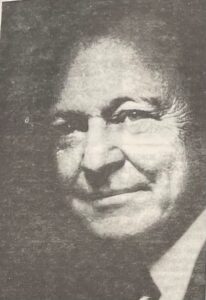
Fig. 3: Edmund Ruffin Beckwith.
Reginald Heber Smith
Smith joined the six-man Boston firm of Hale and Dorr as managing partner in 1919, and he remained in that position until 1956. The firm, now Wilmer Cutler Pickering Hale and Dorr LLP, reports on its website that Smith pioneered the use of the billable hour to rationalize the operations of the law firm, along with “[a]ccurate accounting methods, budgets, a mathematical system of profit distribution, [and] timesheets,” over the objections and resistance of his partners. He first made use of these techniques as counsel to the Boston Legal Aid Society after graduating from Harvard Law School in 1913, reducing the average net cost of handling a legal aid case from $3.93 to $1.63 in just two years.
Smith’s 1919 book, Justice and the Poor, based on his experiences as director of the Boston Legal Aid Society, has been called “one of the most important books about the legal profession in history” because of his finding that “people without money were denied access to the courts,” which “undermined the social fabric of the nation.”[1] His book “shamed the elite bar into action and led to the creation of the modern legal aid movement” by arguing that “[w]ithout equal access to the law, the system not only robs the poor of their only protection, but places in the hands of their oppressors the most powerful and ruthless weapon ever invented.”[2] His book led the ABA to create the Special Committee on Legal Aid Work, resulting in the establishment of legal aid programs across the country by the middle of the twentieth century. Smith also published four articles about the rationalization of law firm operations that the ABA published in book form in 1943 under the title Law Office Organization, which went through eleven editions by the early 1990s. Smith’s public service through the ABA also encompassed the creation of lawyer referral services for people of modest means, the establishment of client security funds, and advocating for vigorous professional discipline. Smith’s contributions to the ABA, which the ABA characterized as “prodigious,”[3] led to his becoming the seventeenth recipient of the ABA Medal, its highest honor, in 1951.
Smith’s cofounding of the CCFL was of a piece with his other public service. His “Inaugural Statement” for the Quarterly Report in 1946 encapsulated some of his thoughts on the role of lawyers in society in connection with the field of consumer finance. For example, he asked, “[W]hat should be the maximum charge on a $25.00 loan? Economics says one thing, sociology says the opposite, and the law, forced to compromise, wavers in an unstable equilibrium.” He further noted that
[j]ustice in this country is administered 10% by judges in court rooms and 90% by lawyers in law offices. In that process we have learned that many of our severest battles are with our own clients; anger and vengeance have to be extirpated from their minds and emotions, and a sense of justice instilled. We have to teach them the limits of law; that, for example, no statute or code can rekindle the flame of love that has been extinguished between husband and wife.
Edmund Ruffin Beckwith
Cofounder Beckwith served as chairman of the Conference’s General Committee until his death in 1949.
Beckwith practiced law in Montgomery, Alabama, for ten years after his graduation from University of Alabama Law School in 1915 and then relocated to New York City to serve as counsel to “a group of companies engaged in the field of consumer finance,”[4] which he combined to form Beneficial Industrial Loan Corporation, later known as Beneficial Finance Corporation.
Beckwith also joined the New York State Guard and became its judge advocate general in 1940, retiring from service with the rank of brigadier general. During World War II, “he perceived that the new citizen-army would insist on legal assistance as well as medical assistance” in all parts of the world.[5] To achieve that goal, “he proposed to rally the whole force of the organized bar—national, state, and local” and successfully carried through on that unprecedented proposal despite the doubts and opposition of many “eminent lawyers and devout patriots” who maintained that “it could not be done and so would lead to disaster.”[6]
Beckwith’s memorial stated that his work caused him to want to do something to benefit the public as well as his clients:
As he studied the economic matrix in which his corporate structure must be formed he was appalled to find that in our democracy the average man had so much difficulty in obtaining credit on simple, clean, and decent terms. He was enraged that the legal provisions were conflicting, inadequate, or altogether lacking.
He proposed to do something about it, and his sure instinct told him to proceed through the instrumentality of the legal profession.
Thus was born the Conference, of which he was the guiding spirit for the remainder of his life and the active head except for the periods when he was in the service of his country.[7]
The Leadership and Activities of the Conference
Leadership of the Conference
In the first issue of the Quarterly Report in 1946, Beckwith was shown as chairman of the General Committee (“Committee”), which included eleven other men. Among them were Smith, who became president of the Conference the following year; Jackson R. Collins (1896–1978) (figure 4), secretary of the Committee from 1946 to 1963 and last survivor of the original 1927 group of thirty founders when he died in 1978; Linn K. Twinem (1903–1997) (figure 5), assistant secretary of the Committee, editor of the Quarterly Report, and general counsel of Beneficial Finance Corporation of New York; and James C. Sheppard (1898–1964) (figure 6), a founding member of the Los Angeles firm that would become Sheppard Mullin Richter and Hampton and Beckwith’s successor as Committee chairman in 1949. These men formed a close-knit group as they performed leadership functions for the Conference for many years.
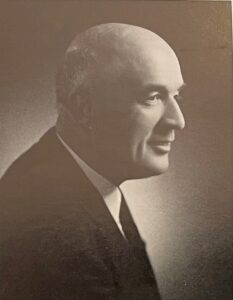
Fig. 4: Jackson R. Collins.
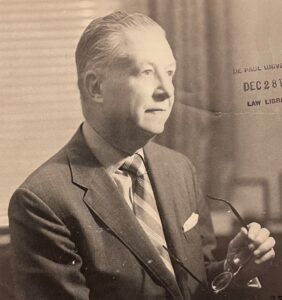
Fig. 5: Linn K. Twinem.

Fig. 6: James C. Sheppard.
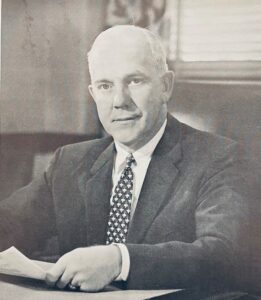
Fig. 7: George R. Richter Jr.
Sheppard remained chairman of the Committee through 1962, when his partner, George R. Richter Jr. (1910–2002) (figure 7), took over the chairmanship through 1979 after he had served in the newly created position of vice president from 1960 to 1962. Before that, Richter had been added as Commercial Code editor for the Quarterly Report in 1951 as the Uniform Commercial Code (“UCC”) was being drafted and finalized for submission to the state legislatures; he served in that function through 1986. Among other things, Richter was the California commissioner for the National Conference of Commissioners on Uniform State Laws, now the Uniform Law Commission, and was elected its president in 1959. He also served as chairman of the ABA Section of Corporation, Banking and Business Law, now the Business Law Section, from 1962 to 1963.
Activities of the Conference
The Conference held its twenty-fifth Annual Meeting at the ABA’s Annual Meeting in San Francisco in September 1952, indicating that it had held similar meetings each year after being founded in 1927. The same issue of the Quarterly Report that reported on the Conference’s Annual Meeting also announced that the General Committee of the Conference would hold its midyear meeting in Chicago in February 1953, in connection with the ABA’s midyear meeting, at which “[s]pecial projects of the Conference will be discussed and considered.” The same pattern holds true to the present as the Conference’s Governing Committee, as the General Committee was renamed in 1991, has held its Annual Meeting and midyear meeting in conjunction with ABA or Business Law Section meetings, discussing and considering projects for the Conference and other business.
The report on the twenty-fifth Annual Meeting consisted of several photographs that showed what the General Committee did. Chairman Sheppard handed out twenty-five-year awards to the three remaining founding members of the Conference. Other photos showed the judges and participants in the Annual Argument that the Conference staged on a current issue, with the participants being drawn from the ABA Young Lawyers Division. The Annual Argument was a prominent feature of the Quarterly Report from that point forward through 1989, with judges being prominent jurists like California Supreme Court Justice Roger J. Traynor or prominent attorneys like University of Texas School of Law Dean W. Page Keeton. In 1990, the Annual Argument was replaced by the first annual Frederick G. Fisher Jr. Memorial Lecture, also presented at the ABA or Business Law Section’s Annual or Spring Meeting until the COVID-19 pandemic upended all in-person meetings in 2019.
Along with the report on the twenty-fifth Annual Meeting, the Quarterly Report announced the Conference’s first annual law student writing contest, cosponsored by the ABA’s Law Student Program. For first, second, and third prizes of $500, $250, and $150, respectively, which in those days could pay for a significant portion of a year’s law school tuition, contestants were to write essays of not more than 2,500 words on a question about current interest rate caps in state statutes and constitutions where case law permitted amounts paid to third parties for collateral expenses to be charged, but not always if the lender’s employees rendered such services. The question to be answered was this:
What is the present state of the law, and what should be the policy of the law, with respect to reasonable charges made by the lender for services rendered by the lender or his staff? Should the lender be permitted to or should it be prohibited?[8]
From its beginning through the commencement of the Quarterly Report, the Conference was largely concerned with the state laws that regulated, or failed to regulate, small personal loans and with case law developments on that subject because no federal law existed at that time that dealt with consumer finance issues. Even the UCC was nothing more than a gleam in some law professors’ eyes at that time.
When the UCC became a reality, it was clear to the leaders of the Conference that this was a momentous change, particularly the provisions of Article 9 that dealt with security for financial transactions. This development led Richter to produce a six-part series from the Winter 1951 issue through the Summer 1953 issue in which he and five other authors thoroughly explained what was in Article 9 and its ramifications for personal finance.
During this period, the Conference also began to sponsor stand-alone programs that presented panel discussions on the latest developments in consumer finance law for the benefit of the practicing bar. The first such program was presented at the New York University Law Center in April 1953.
The Next Generation
The early 1970s marked momentous changes for the Conference as the founders retired to emeritus status or passed away. The first federal consumer law, the Truth in Lending Act (“TILA”), which imposed a uniform system of disclosures on all forms of consumer credit but left interest rates for the states to regulate, was enacted in 1968. This was followed by many more federal laws that regulated consumer finance. The Federal Reserve Board also drafted sets of implementing federal regulations for these statutes that grew in length and complexity as the years rolled by.

Fig. 8: Lawrence A. Young.
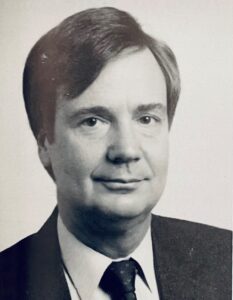
Fig. 9: Alvin C. Harrell.
The Changing of the Guard
As the new federal regulatory regime for consumer finance emerged, a new editor for the Quarterly Report, Lawrence A. Young (1943–2022) (figure 8), who started his career at Beneficial Finance in New Jersey and then had a long private practice at firms in Houston, succeeded Twinem in 1977. Young edited the Quarterly Report through mid-1984, when Bernice B. Stein took over. She in turn was succeeded in 1988 by Alvin C. Harrell (figure 9), professor at Oklahoma City University School of Law, who edited the Quarterly Report until his retirement in 2017. Harrell also edited the “Annual Survey on Consumer Finance Law” in The Business Lawyer for twenty-two years, until 2013.
The leadership of the Conference also changed. Fisher, mentioned above, succeeded Richter as chairman from 1980 until his death in 1989. As Young often told the story at the start of the Frederick Fisher Memorial Program at the Spring Meeting of the ABA Business Law Section, a young Fred Fisher came to the public’s attention in 1954 when he was attacked by Senator Joseph McCarthy as a suspected Communist in an attempt to smear his boss, the U.S. Army’s counsel, Joseph Welch of Hale and Dorr, during the McCarthy-Army hearings in which McCarthy accused the Army of harboring Communists. Welch’s emotional defense of Fisher during the televised hearings turned the public mood against McCarthy and led to his eventual disgrace and downfall. During Fisher’s long tenure at Hale and Dorr, he held many positions in the ABA and became president of the Massachusetts Bar Association from 1973 to 1974.
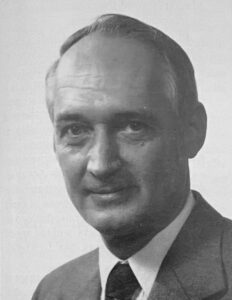
Fig. 10: Walter F. Emmons.

Fig. 11: Lawrence X. Pusateri.
Upon his death, Fisher was succeeded as chairman by Walter F. Emmons (1928–2013) (figure 10) for two years and then by Lawrence X. Pusateri (1931–2005) (figure 11) from 1993 to 1998. Pusateri was the first summa cum laude graduate of DePaul University College of Law in Chicago when he graduated in 1953 and had a varied and interesting career thereafter. As an assistant staff judge advocate in the U.S. Army from 1954 to 1957, he was a prosecutor in the famed Bamberg, Germany, rape trial in which the seven defendants were convicted, which became the subject of the movie Town Without Pity in 1961. He then served two terms in the Illinois House of Representatives and became president of the Illinois State Bar Association. After serving as a justice of the Illinois Appellate Court, Pusateri reentered private practice and focused on consumer finance law.
Changes in the Quarterly Report
Young once told the author of this article that the Quarterly Report was “pamphlet-sized” before Harrell became its editor. This was confirmed by surveying the extant issues. The Quarterly Report under Twinem as editor had about 80 pages per year in 1947 and 1948, then grew to 100–160 pages from 1959 to 1976. Under Young as editor, it had a range of 76–108 pages from 1977 through 1984; it then had a range of 56–64 pages through 1987 under Stein as editor. One noticeable feature for today’s reader is the almost total absence of footnotes in the Quarterly Report from 1946 through 1987.
When Harrell became editor in 1988, the Quarterly Report suddenly became a full-fledged law review, with every article thoroughly footnoted. It also mushroomed in size, going from 56 pages in volume 41 under editor Stein to 224 pages in volume 42 under Harrell—and then to 274 pages in volume 43 and 398 pages in volume 45. Law professors’ articles began to be published with some frequency.
Even before the panoply of federal laws regulating consumer finance began to be enacted in 1968, the Quarterly Report’s growth in the 1950s reflected the expansion of its coverage beyond the regulation of personal loans. Consumer bankruptcy law, a subject of great importance to small loan lenders, became a frequent topic. Each state’s enactment of the UCC was chronicled. Mortgage lending and auto finance also became important topics.
In the 1960s and 1970s, each new federal consumer finance law received suitable coverage in the Quarterly Report, as did the development and state enactment of the Uniform Consumer Credit Code (“U3C”). For example, just as when Article 9 of the new UCC was discussed at length in a six-part series of articles, the proposed disclosure regimens in the TILA and the U3C were introduced to the readership of the Quarterly Report in 1967. When the TILA became law, another article explained what was in the final enactment. The “private attorney general” provisions of the TILA that enabled and encouraged private litigants to file class actions, which have been a fruitful source of employment for consumer finance litigators as well as fertile ground for legal commentators to the present day, were also covered in an early Quarterly Report article. The 1967 Annual Argument dealt with the question of whether a federal statute could validly prohibit discrimination by lending institutions well before the Equal Credit Opportunity Act was enacted in 1974.
The CCFL and the Quarterly Report Enter the Twenty-First Century

Fig. 12: Jerry D. Bringard.
At the turn of the twenty-first century, the CCFL’s leadership began a regular rotation. Jerry D. Bringard (figure 12), who had been president for six years during Pusateri’s chairmanship, became chairman for two years from 1999 to 2000. Young then became chairman from 2001 to 2002. The rotation of officers became institutionalized when the Governing Committee of the CCFL adopted bylaws in 2003. Three-year terms were established for the chairman, who was to be automatically succeeded by the president when the term ended, and the other officers.
The turn of the twenty-first century also brought programming changes to the CCFL. Harrell greatly expanded the CCFL’s programming by instituting specialized two-day seminar programs for bankruptcy, debt collection, mortgage lending, and auto finance in addition to an annual two-day overall compendium of consumer finance law issues similar to the Conference’s original 1953 consumer finance law program. However, attendance at the programs dwindled following the foreclosure crisis of 2007–2008 as financial institutions cut back on personnel and expenses. By the time Harrell presented Consumer Credit 2011 in October of that year, it had become uneconomical for such programming to continue, and the CCFL exited the legal education field.
Consumer finance law developments did not cease during this period, however, and the Quarterly Report continued to cover them in depth. The page count grew to a peak of 516 pages in 1994 and continued in the range of 300 or more pages from 1995 to 2005. Volume 60 carried a record 722 pages in 2006—and then the record was broken with 954 pages in volume 61. For the rest of Harrell’s tenure as editor, the Quarterly Report comprised 300 or more pages per volume. A myriad of consumer finance topics was covered, paying close attention to state law developments as well as all of the federal law developments both before and after the landmark sixteen-title Dodd-Frank Wall Street Reform and Consumer Protection Act was enacted in 2010 and a new federal agency, the Consumer Financial Protection Bureau, was created to oversee the federal law end of things.
Following Harrell’s retirement in 2017, changes were made to streamline the Quarterly Report and to more fully engage the members of the Governing Committee, which now has more than one hundred members drawn from law firms and in-house counsel offices in all parts of the country, in the operations of the CCFL. Professors Ramona L. Lampley and Chad J. Pomeroy of St. Mary’s University School of Law were recruited to serve as co–executive directors and coeditors of the Quarterly Report.
The CCFL reinstituted two-day seminars in 2016 in partnership with Loyola University Chicago School of Law and Texas A&M University School of Law. After the programs went virtual during the pandemic, live seminar programming resumed in 2022.
With an expanded group of officers as well as a large, diverse Governing Committee whose members are committed to participating in its mission to “encourage study and research in the field of consumer finance law,” to “promote, through education, the sound development of consumer finance law,” and to “provide a forum through which interested persons may exchange opinions,”[9] the CCFL is well positioned to continue for its second century to exercise the leadership that it has exercised in this field since 1927.
John L. Ropiequet is of counsel to the Litigation Group at Saul Ewing LLP’s Chicago office, where he has practiced since 1973. John was chairman of the Conference on Consumer Finance Law from 2015 to 2018, is a fellow of the American College of Consumer Finance Lawyers, and has been coeditor of the “Annual Survey on Consumer Finance Law” in The Business Lawyer since 2012. He is also coeditor of The Law of Truth in Lending (4th ed. forthcoming 2023), has published scores of articles in The Business Lawyer and other publications, and is the author of countless thousands of footnotes.
See John M.A. DiPippa, Reginald Heber Smith and Justice and the Poor in the 21st Century, 40 Campbell L. Rev. 73 (2018) (abstract), https://scholarship.law.campbell.edu/clr/vol40/iss1/3/. ↑
See Justice and the Poor, https://en.wikipedia.org/wiki/Justice_and_the_Poor (last visited Dec. 23, 2022). ↑
Reginald Heber Smith, 1889-1966, 52 Am. Bar Ass’n J. 1138 (1966) ↑
See Jackson R. Collins, DeVane K. Jones & Reginald Heber Smith, Memorial Statement, 4 Q. Rep. 3 (1949). ↑
See id. at 4. ↑
Id. ↑
Id. at 3. ↑
See Announcement – 1953-54 Essay Contest, 7 Q. Rep. 98 (1953). ↑
See Mission Statement, 75 Consumer Fin. L.Q. Rep. ii (No. 4, 2021). ↑


